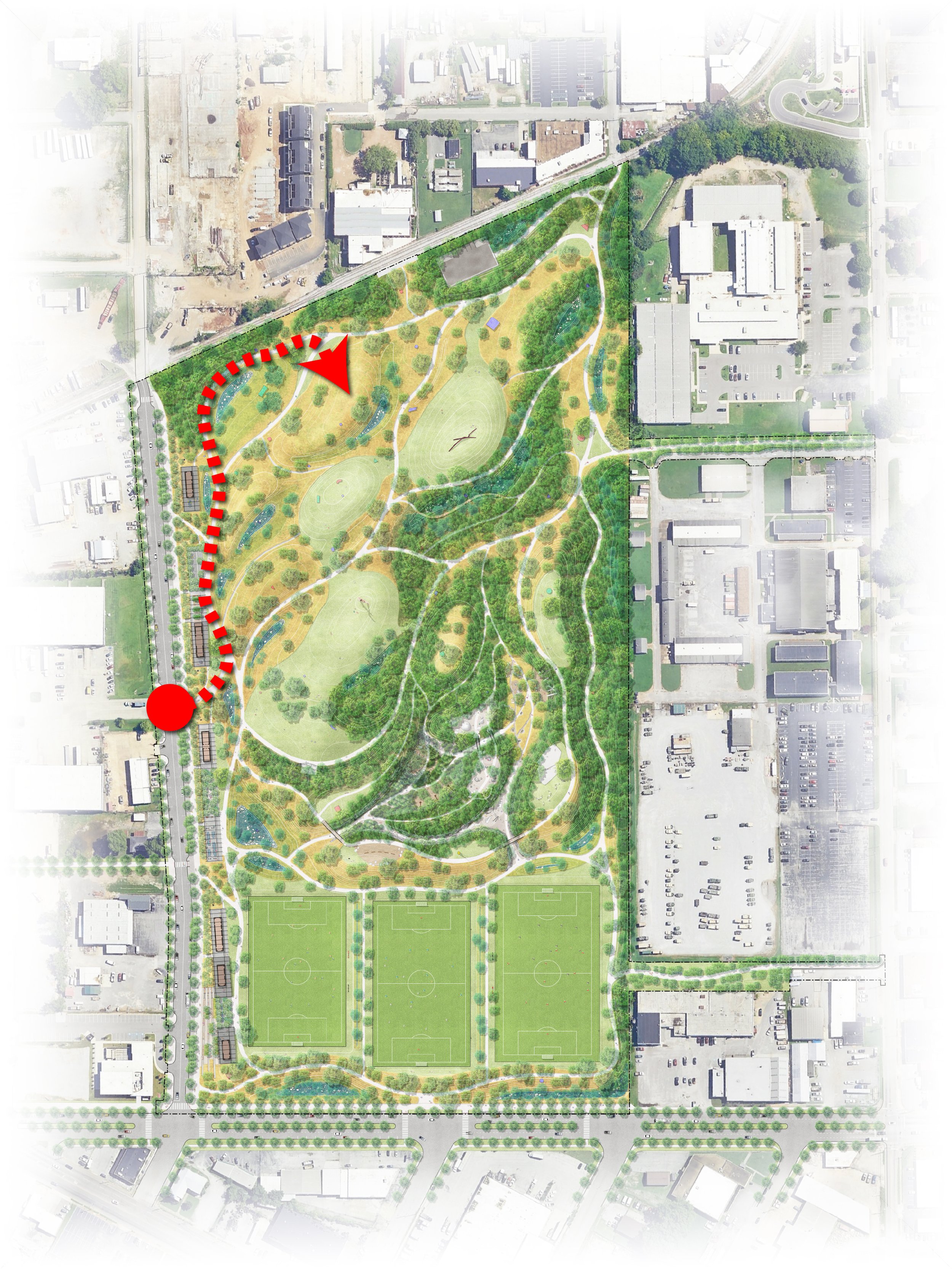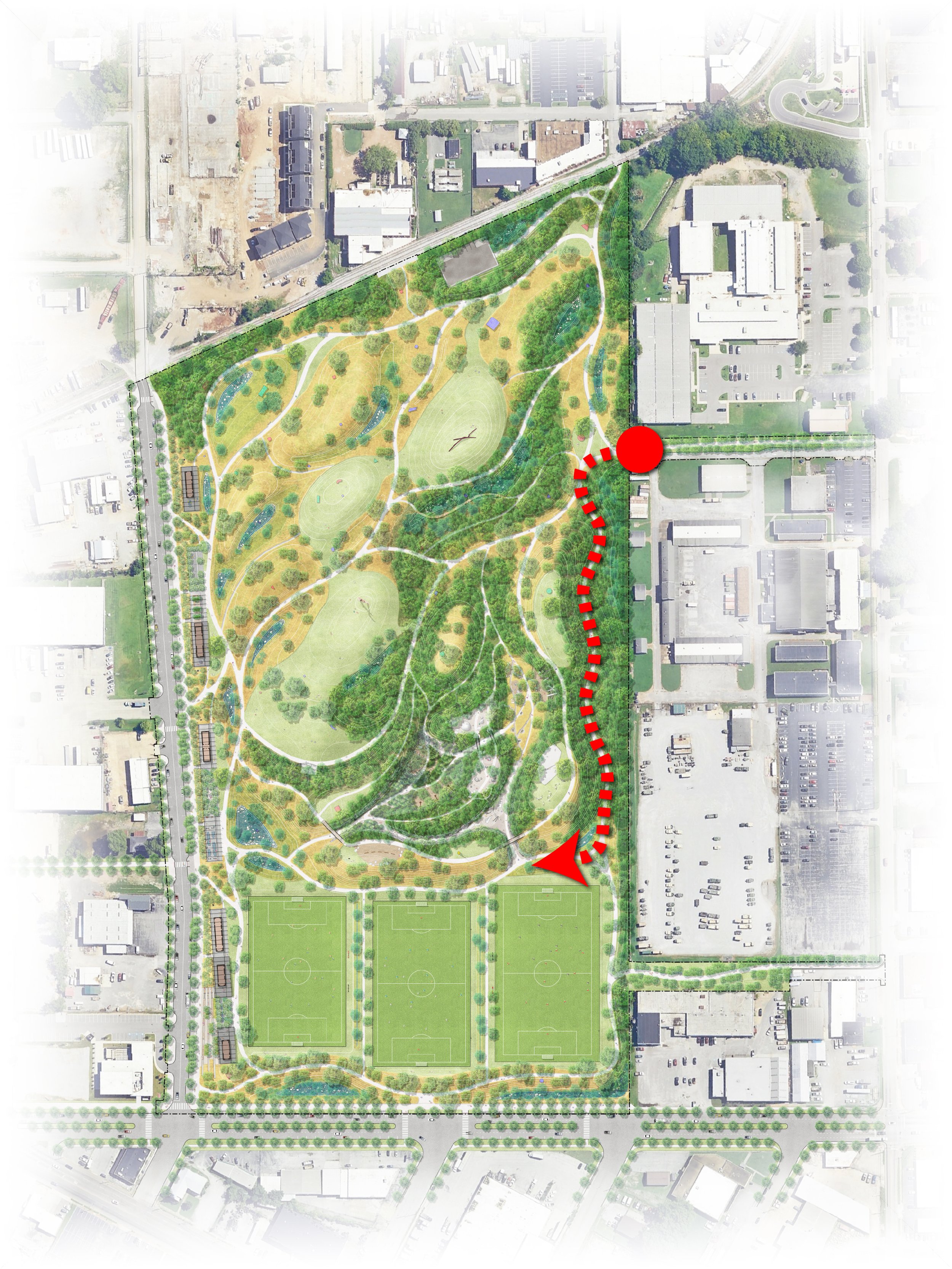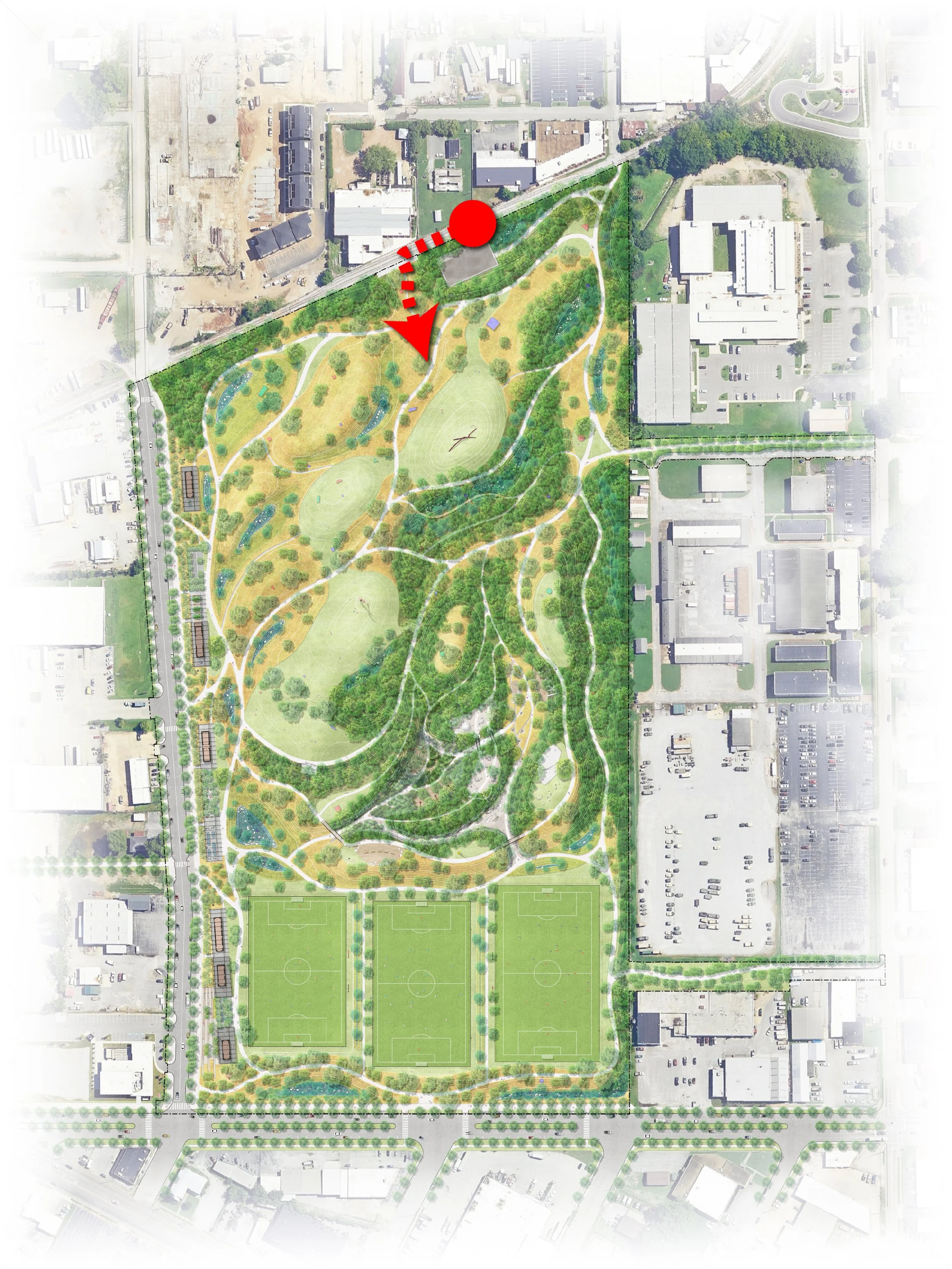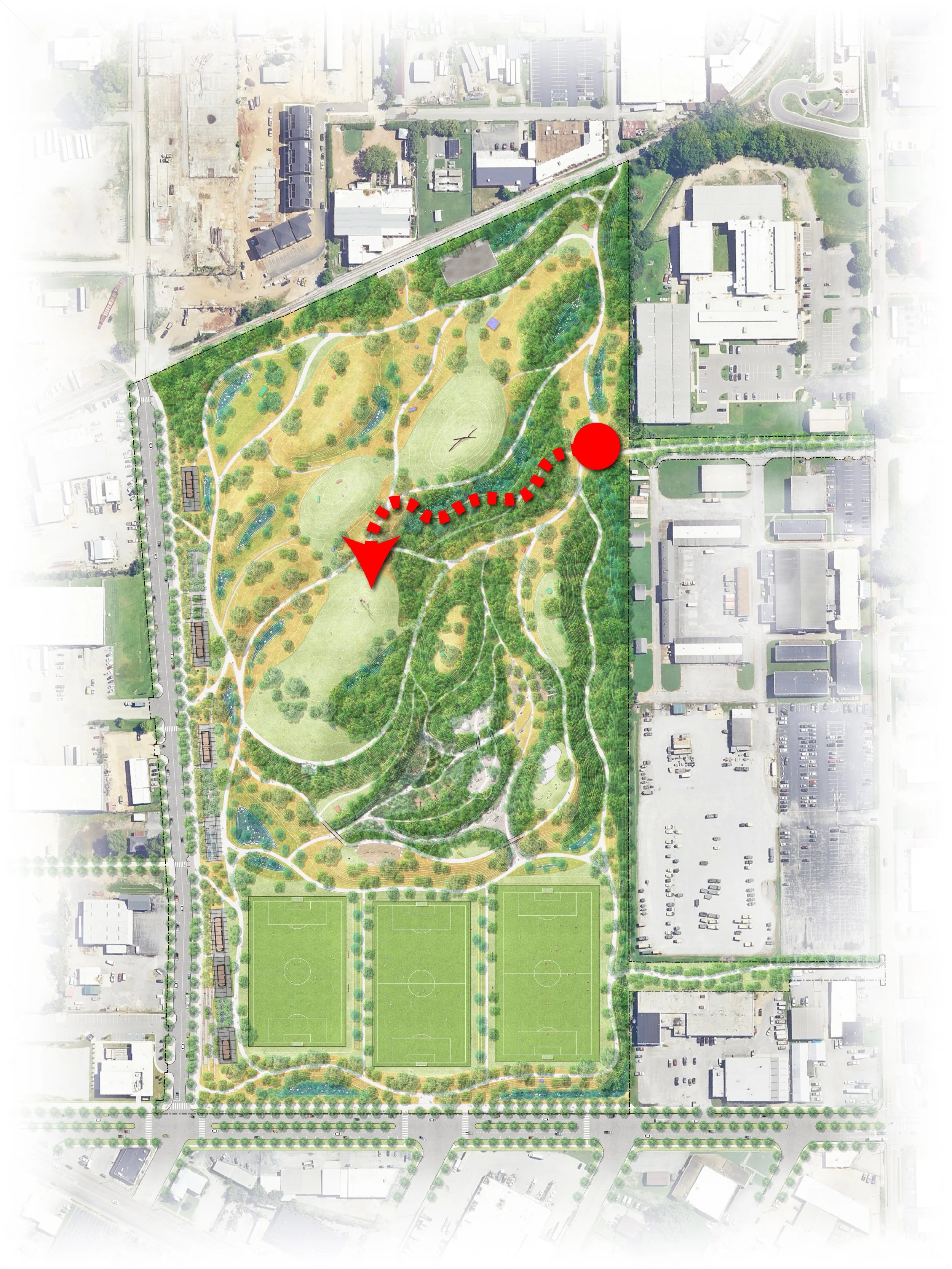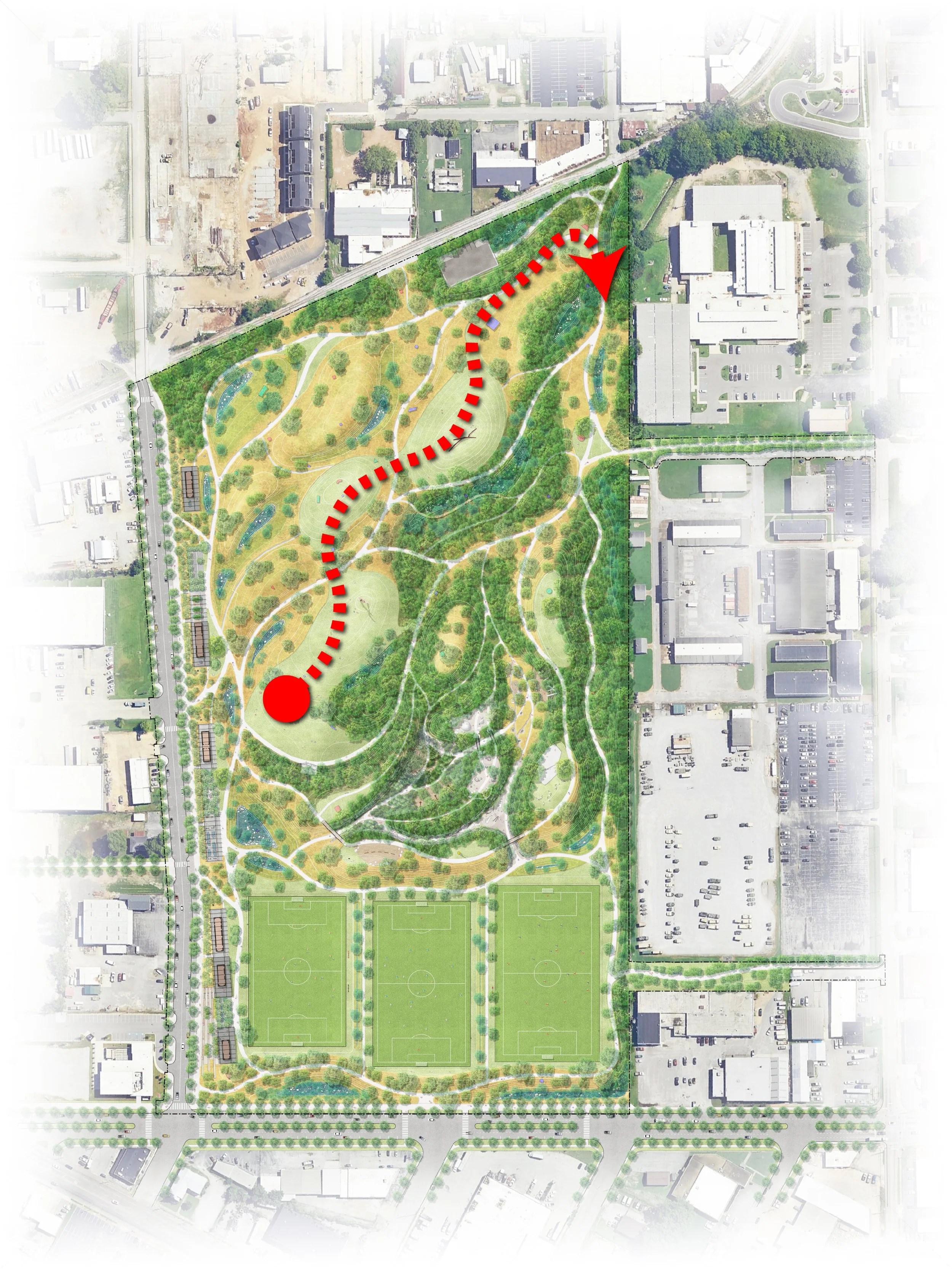The Vision Plan Walkthroughs
Let's travel in time to the not-so-distant future of Montague Park! We begin our journey at the corner of 23rd and Polk Streets, turning north onto Polk and stopping at the dropoff point for the entrance to the athletic fields. We enter the park up the community steps, a place to gather, as well as a place to await drop off and pick up, and on to the Spectator Terrace with a view across the three new athletic fields that will activate the southern end of the park. To the left is the southern end of "the Civic Edge," which forms a linear threshold of buildings that will service the park from the southwest to northwest end.
As we turn left, we continue north along “the Civic Edge”, a series of terraces with pavilions, overhead arbors, and outdoor program that forms a linear threshold along this side of the park. . The Spectator Terrace will include vending, restrooms, team locker rooms, as well as administrative space for the Chattanooga Football Club Foundation, who will oversee the recreational operations of the fields and their dedicated service spaces.
*Sculptures shown are place holders, final sculpture locations to be determined in coordination with Sculpture Fields at Montague Park.
Polk Street Entrance at the Spectator Terrace
We will look today at the future "main entrance" to the park (one of many new accessible park entrances), located near the center along the Polk Street edge of the park across from the Sculpture Fields at Montague Park office. Stepping onto the sidewalk, we turn left to see a new 12'-0" wide shared use path for bikes and pedestrians, which can be activated at times by a pop-up market. As we move through the main entrance through the Civic Edge on the right, we enter the Sculpture Fields outdoor museum, with the framed view of the iconic Peter Lundberg work known as "Anchors".
Continuing north along the primary park loop path, the Living Terrace is on our right. We catch a glimpse of the Green Room, which will serve as a flexible venue and support space for performances, changing rooms for weddings, and other events the new park will bring. Continuing north, we see the more gently playful elements on the terrace--community porch swings, outdoor seating, and a bocce bosque. As we continue, we pass the maintenance pavilion dedicated to supporting the Parks and Outdoors on-site staff and volunteer activities. Continuing along the path takes us through the northwest portion of the Sculpture Fields, with added native trees and meadows providing a variety of settings to display outdoor sculpture.
*Sculptures shown are place holders, final sculpture locations to be determined in coordination with Sculpture Fields at Montague Park.
Main Entrance and Civic Edge
23rd Street Entrance
We begin this walk headed west on the new shared use path along a reimagined 23rd Street. Across the street to our left, we see Clínica Médicos, and soon we take a right to begin a gentle ascent into the southern end of the park marked by new signage and park maps for wayfinding.This primary park path is is a mile long loop that connects all areas of the park - a perfect way to measure runs and walks, or just to casually stroll and pass the time. As we take a right towards the three new athletic fields, you are able to see the ridges of the "Heart" of the park visible in the background, elevating John Henry's monumental yellow sculpture, "Best for Last” - his final work.
*Sculptures shown are place holders, final sculpture locations to be determined in coordination with Sculpture Fields at Montague Park.
Today we find ourselves at a new entrance on the east side of Montague Park at 18th Street, also once known as Montague Street. This new shared use path runs between the Armory and the Austin Hatcher Foundation to connect the park to Holtzclaw and the neighborhoods to the east. As we enter the park through Sculpture Fields, we pass by bike parking, new signage, and flexible lawns for displaying sculpture, and soon take a left to head south along the “woodland walk” that follows the park’s eastern edge.
The winding and shaded nature of the path lends itself to one of quiet discovery with landforms rising up on either side. Each turn reveals thoughtfully placed sculpture, moments to sit and rest, and new path lighting to allow for evening park use. The path, a part of the mile-long loop, continues south until opening up at the new athletic fields with a view to Lookout Mountain in the background.
*Sculptures shown are place holders, final sculpture locations to be determined in coordination with Sculpture Fields at Montague Park.
18th Street Entrance & Woodland Walk
All aboard! Did you know that there is a train stop at Montague Park? The northern edge of the park serves as the final stop of the Tennessee Valley Railroad Museum’s dinner train route before turning back to the museum, but it is currently not easy for passengers to get out and take advantage of the park.
In the future, however, there will be a platform to serve this train and any other TVRRM excursions for ease of access to the park. The platform is to be named the “John Henry Platform,” Named in honor of the founder of the Sculpture Fields, the John Henry Platform is intended to mimic his view of Sculpture Fields from the balcony of his studio just beyond the tracks. As we step off the platform into the Sculpture Fields, John Henry’s “Bette Davis Eyes” is visible atop a rolling landform beyond the meadow in the distance.
*Sculptures shown are place holders, final sculpture locations to be determined in coordination with Sculpture Fields at Montague Park.
John Henry Platform Entrance
The Heart’s Ridge Walk
Today we begin our walk in one of the most exciting new features of the Montague Park, “The Heart.” Located in the southern portion of Sculpture Fields in the center of the park, the Heart will provide an immersive and varied experience, featuring deep valley cuts, long views, and bridges and walks along the highest elevations in the park. Formed by wooded ridges and valleys, the Heart evokes the regional landscape of Chattanooga, while providing a mixture of experiences, including opportunities for play and movement for all ages, to places of quiet reflection in the presence of sculptures.
As we follow the path traveling south, we ascend the easternmost ridge of the Heart. To the right we see the Talus slides, which will be built into the hillside to give access to the play valley below. Continuing south, we find ourselves in the hammock grove. As we curve to the right, we begin to catch glimpses of the athletic fields to the left, and when crossing a new pedestrian bridge to the next ridge, we look right down into the Canyon Scramble.
As we continue west, we pass alongside John Henry’s last piece, “Best for Last,” prominently located for visibility throughout the park and beyond. The path continues, leading us to the Lookout Swings, monumental swings that will line the crest of the ridge to provide views of the athletic fields below, and Lookout Mountain beyond.
*Sculptures shown are place holders, final sculpture locations to be determined in coordination with Sculpture Fields at Montague Park.
Today we’re visiting a unique moment within Sculpture Fields, the Wet Woodland . This grove of cypress trees serves as one of the many features of the park dedicated to stormwater management through the creation of wetland areas meant to lessen the park’s impact on area flooding. Here one enters a place with a distinct character of native flora and fauna, providing a unique micro climate for plants and animals, and cool shade in the summer months for park visitors.
Upon entering the wetter areas, the path transitions to an elevated boardwalk, passing sculptures along its route. The meandering path leads us out to Sculpture Fields into an opening in the native meadow which forms Great Lawn, standing in the shadow of the iconic Peter Lundberg’s “Anchors” sculpture.
*Sculptures shown are place holders, final sculpture locations to be determined in coordination with Sculpture Fields at Montague Park.
The Sculpture Fields’ Cypress Boardwalk
Our time travels continue through the Heart of Montague Park. Entering from the CFCF athletic fields traveling east, we pass between two landforms and below a pedestrian bridges into the Heart. Evocative of the limestone formations typical of the Chattanooga region, the canyon and other features in the park are constructed of reclaimed and recycled materials. The experience of the canyon is narrow and cool, providing opportunities to scurry up and down stacked concrete blocks before opening up at the other end to scrambles for climbing near one of the other pedestrian bridges and entrances to The Heart, with the athletic fields beyond.
The Heart and Play Canyon
We begin today’s walk in the Great Lawn, a flexible open lawn that will accommodate community gatherings and events of around 2,000 people. As we approachPeter Lundberg’s Anchors, we enter into the core of the Sculpture Fields, moving through a series of galleries’ in the lawn. With the addition of trees and native meadow, John Henry’s original vision of outdoor rooms defined by planting to create a varied outdoor museum experience comes to life. Moving northeast through the sculpture galleries, we encounter John Henry’s Bette Davis Eyes, along with many other sculptures recognizable in the park today. The rolling and connected lawns join back with the perimeter loop path, giving visitors a ‘choose your own adventure’ itinerary with endless ways to move through the park.
*Sculptures shown are place holders, final sculpture locations to be determined in coordination with Sculpture Fields at Montague Park.
The Sculpture Fields’ Lawn Walk
Strap on your jetpacks! In our final trip to the future of Montague Park, we end our journey with a flyover of the entire park. We begin our flight on the southern end of the park looking northwest, where we soon descend to get a better view of the athletic fields. Descending further as we turn to the north, we see the extent of the Polk Street improvements and the Civic Edge.
We turn to hover over the expansive Great Lawn and outdoor gathering area that connects to a series of open lawn galleries carved out of native meadow and drifts of woodlands. From there we get an overview of the Sculpture Fields, with many recognizable sculptures shown from above. As we circle around and fly south, we are given a full view of the Heart’s immersive and wooded ridges, play valleys, and bridge crossings with the athletic fields beyond. And finally, we end our journey touching down in the center of the Great Lawn, looking up at Peter Lundberg’s iconic “Anchors” sculpture.
*Sculptures shown are place holders, final sculpture locations to be determined in coordination with Sculpture Fields at Montague Park.


